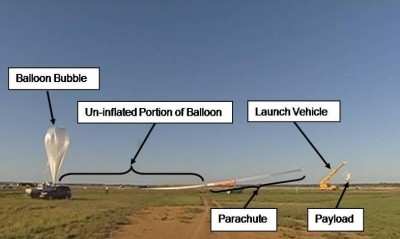Fri, Dec 17, 2010
Balloons Had Been Grounded Since An Accident In Australia In
April
NASA's scientific balloon program is resuming flights this month
after an extensive evaluation of its safety processes following a
mishap during an April launch attempt from Australia. NASA's
high-altitude balloons fly instruments for scientific and
technological investigations that contribute to our understanding
of Earth, the solar system, and the universe.

Balloon Launch Configuration From Final Report
In October, a NASA mishap review board listed 25 causes that
contributed to the accident, including insufficient risk analysis,
contingency planning, personnel training, government oversight and
public safety accommodations."NASA's Goddard Space Flight Center,
Wallops Flight Facility, and contractor balloon team have done an
outstanding job over the past eight months to develop and implement
plans to return the balloons to flight," said Jon Morse, director
of the Astrophysics Division in the Science Mission Directorate at
NASA Headquarters in Washington. "We look forward to once again
conducting groundbreaking science with these balloon systems."
To prepare for the resumption of flights, NASA developed a
corrective action plan to address the recommendations from the
mishap review. To return to flight, NASA has:
- Developed a more stringent launch safety area in which the
balloon launch vehicle can maneuver in order to protect the safety
of the public.
- Revised the safety procedures used to conduct balloon
launches.
- Instituted NASA independent ground and flight safety roles to
ensure that balloon launches are conducted safely.
- Redesigned the launch head mechanism that failed to work
properly during the Australia aborted launch.
- Developed plans to better respond to mishaps and close calls
with respect to balloon launch operations.
NASA has approved flights that are scheduled throughout this
month over Antarctica. During the Antarctica flights, NASA will use
a vehicle that was specifically designed to launch the balloons
instead of a commercially obtained mobile crane, which was used
during the mishap in Australia. The launch vehicle is built to
handle the large, long-duration balloon (LDB) payloads on the
compacted snow launch surface. The LDB program in Antarctica is a
partnership between NASA and the National Science Foundation, and
is carried out through the U.S. Antarctic Program-- a continuous
national research presence on the continent since 1956 that is
managed by NSF.

NASA's scientific balloons are composed of a lightweight
polyethylene film, similar to sandwich wrap. Flying to altitudes of
nearly 25 miles, many of the balloons inflate to almost the size of
a football stadium and carry payloads weighing up to 6,000
pounds.
More News
Light Gun A handheld directional light signaling device which emits a brilliant narrow beam of white, green, or red light as selected by the tower controller. The color and type of>[...]
"The journey to this achievement started nearly a decade ago when a freshly commissioned Gentry, driven by a fascination with new technologies and a desire to contribute significan>[...]
Aero Linx: JAARS, Inc. For decades now, we’ve landed planes on narrow rivers and towering mountains. We’ve outfitted boats and vehicles to reach villages that rarely se>[...]
"Our driven and innovative team of military and civilian Airmen delivers combat power daily, ensuring our nation is ready today and tomorrow." Source: General Duke Richardson, AFMC>[...]
Aircraft Conflict Predicted conflict, within EDST of two aircraft, or between aircraft and airspace. A Red alert is used for conflicts when the predicted minimum separation is 5 na>[...]
 ANN's Daily Aero-Term (04.20.24): Light Gun
ANN's Daily Aero-Term (04.20.24): Light Gun Aero-News: Quote of the Day (04.20.24)
Aero-News: Quote of the Day (04.20.24) ANN's Daily Aero-Linx (04.21.24)
ANN's Daily Aero-Linx (04.21.24) Aero-News: Quote of the Day (04.21.24)
Aero-News: Quote of the Day (04.21.24) ANN's Daily Aero-Term (04.21.24): Aircraft Conflict
ANN's Daily Aero-Term (04.21.24): Aircraft Conflict




